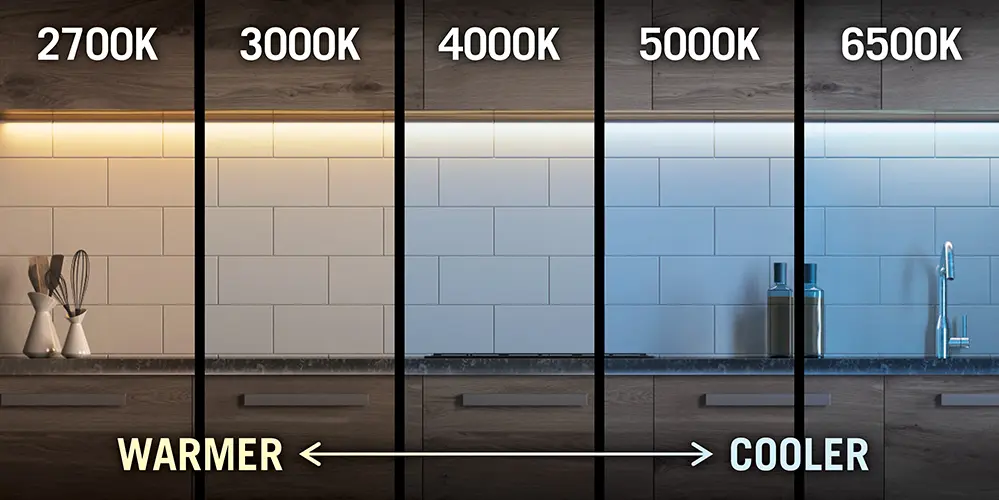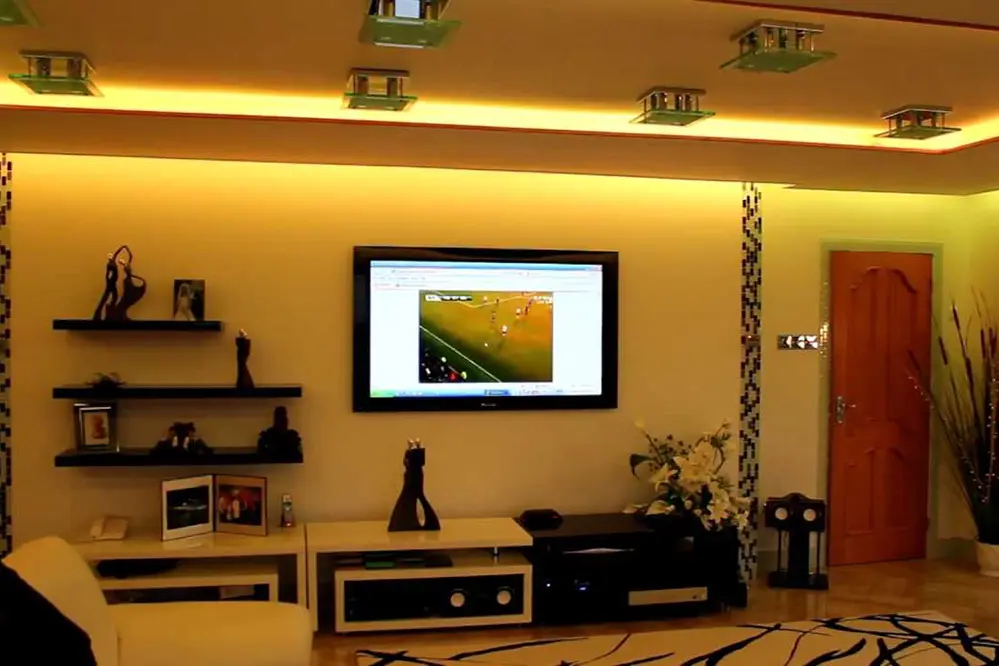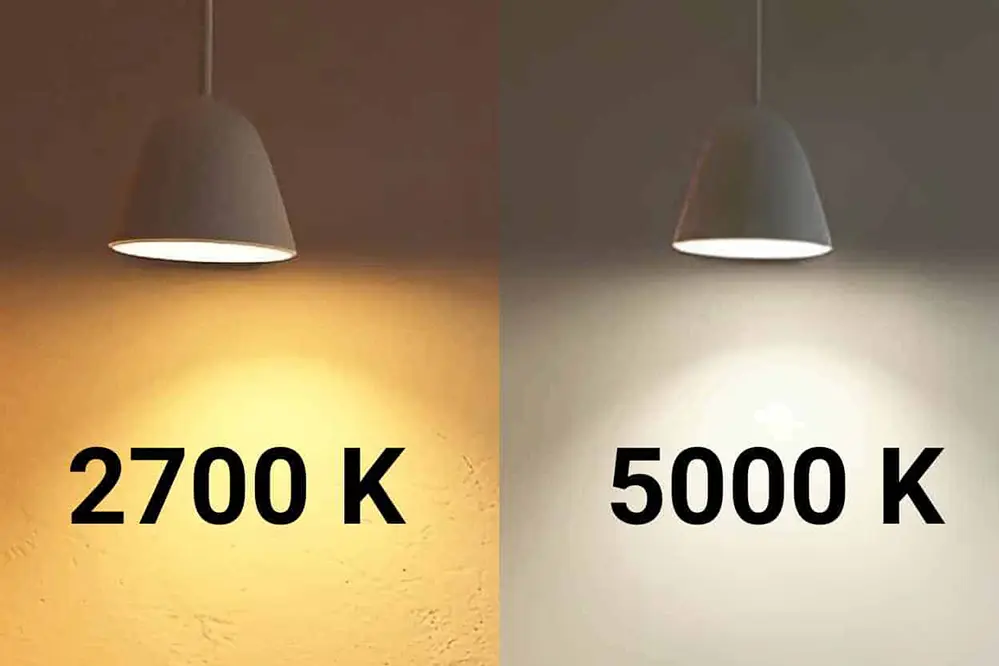Venturing through the landscape of LED lighting is akin to watching the gradual shift of the sky from dawn to midday – subtle, yet profoundly impactful. The color of light sets the stage for our perception of the world:
2700K represents the warm, cozy glow of early morning light.
5000K embodies the bright, alert clarity of a midday sun.
In lighting design, these Kelvin temperatures shape the ambience and functionality of a space, guiding our visual experiences.
Decoding Kelvin Scale in Lighting

The Kelvin scale, integral to understanding light color temperatures, is a numerical measure of the visual warmth or coolness of a light source. This concept hinges on the correspondence between the hue of light emitted and the temperature to which a theoretical black body would have to be heated to glow in a similar manner. Therefore, 2700K yields a warm, amber hue reminiscent of the setting sun, while a 5000K light source mirrors the crisp, invigorating light of a cloudless noon.
Light sources characterized by different Kelvin temperatures cast diverse effects on their environments. As we delineate between lower Kelvin figures, we conjure images of warmth and relaxation akin to a tranquil, evening retreat. Conversely, higher Kelvin numbers take us to a realm of alertness and focus, suggesting an environment bathed in the vibrant glow of daylight.
Explaining Color Temperature
Color temperature quantifies light hues—warmer or cooler—defining our psychological perception of light’s character.
Early incandescent bulbs produced a cozy 2700K glow, setting a historical baseline for warm residential lighting.
The spectrum stretches from intimate 2700K to stimulating 5000K, shaping spaces for relaxation or precision activities correspondingly, and impacts circadian rhythms, mood, and task performance.
In mastering color temperatures, one masters ambience creation—2700K invites a homely, intimate atmosphere, while 5000K offers clarity and concentration, presenting stark differences in environmental perception.
Relevance of Kelvin Ratings for LEDs
Kelvin ratings are integral to choosing LED lighting that matches the desired ambiance and utility of a space.
- Ambiance Differentiation: Different Kelvin temperatures can transform the mood of a room, with lower Kelvins yielding a warm, inviting glow and higher Kelvins providing a crisp, alert atmosphere.
- Application-Specific Lighting: Selecting the correct Kelvin rating aids in tailoring the lighting to specific tasks or settings, enhancing productivity or relaxation.
- Visual Comfort: A suitable Kelvin rating can reduce eye strain and improve comfort, especially in spaces where individuals spend extended periods.
The precision of the Kelvin rating guides the functionality and aesthetic of lighting design.
Identifying the optimal Kelvin rating is essential for energy-efficient lighting strategies and human-centric design considerations.
2700K LED Characteristics

2700K LEDs produce a warm light, akin to the soft, comforting glow of incandescent bulbs. This color temperature radiates a cozy amber hue, creating intimate and inviting environments. It mirrors the warmth of early morning or late afternoon sun, providing a sense of calm and serenity in interior spaces, making it akin to the soothing radiance of a fireside.
In a domestic context, 2700K LEDs are often favored for living areas and bedrooms where a “soft white” ambience is desired. Their restful light spectrum is less likely to disrupt circadian rhythms when compared to cooler temperatures, thus promoting relaxation and sleep. Furthermore, the warm illumination from these LEDs enhances earth tones and wood finishes, accentuating the interior design elements with a touch of nostalgia and elegance.
The Warm Glow of 2700K
Illuminating spaces with 2700K LEDs instills a sense of warmth and comfort. This color temperature is often described as “soft white,” emitting a light that is mellow and inviting to the human eye.
With their golden tones, these LEDs evoke the nostalgia of traditional incandescent bulbs. Their radiance is reminiscent of a tranquil sunset, offering a soothing ambiance that appeals to sensory comfort in residential and hospitality settings.
The 2700K warmth creates an aura of relaxation, particularly conducive to environments designated for unwinding. It’s a popular choice for designers seeking to foster spaces that suggest restfulness and a haven-like retreat from the bustling world outside.
Harnessing the 2700K color temperature strategically enhances the overall aesthetic experience. Its light is flattering to skin tones and complementary to rich, warm-colored furnishings, contributing to an atmosphere of sophistication and harmony.
Designers and lighting professionals often recommend 2700K LEDs for ambient lighting. This application ensures that rooms can bathe in a light that’s both inviting and functionally conducive to human comfort and well-being.
Ideal Uses for Soft White Lighting
Soft white lighting is inherently gentle, making it ideal for living rooms and bedrooms where relaxation is paramount. It also promotes a welcoming atmosphere in hospitality venues.
In dining areas, soft white tones accentuate the warmth of shared meals, enhancing the culinary experience.
This light quality can transform a bathroom into a space of serene tranquility, complementing natural materials and subtle hues with its soft glow. It is particularly effective in spaces where the aim is to calm and soothe, introducing a spa-like ambience.
For spaces imbued with earth tones and natural textures, soft white lighting provides an element of coziness that reinforces the design narrative. It’s unparalleled in areas like libraries and lounges, where comfort meets sophistication. By simulating the early evening light, it encourages relaxation and conversation, and is undeniably the light of choice for areas aiming to create an enclave of comfort and warmth.
5000K LED Attributes

5000K LEDs emit a spectrum akin to noontime daylight, providing crisp, vibrant illumination ideal for task-oriented settings. Recognized for their ability to facilitate concentration and alertness, they are akin to a midday sun’s clarity.
In color critical applications, 5000K lighting ensures color fidelity and sharpness, an essential quality for demanding environments like design studios or surgical suites. Its resemblance to daylight promotes precision in high-detail tasks, making it the preferred choice for work that requires acute visual acuity.
These LEDs render colors more naturally, akin to a daylight scenario, and make details stand out with stark contrast.
Bright and Energetic 5000K
The 5000K light spectrum embodies daylit vitality, closely mimicking the sun at its zenith. Its ability to enhance alertness makes it superb for productivity-focused environments.
Within educational contexts, 5000K LEDs offer an atmosphere that sharpens focus and aids visual clarity, potentially improving academic performance. Similarly, in commercial retail spaces, they provide a high-definition ambiance that accentuates product details and colors.
Critical tasks, like assembly work or intricate craftsmanship, benefit from the brightness and neutrality of 5000K lighting. Here, the stark, clear light reduces eye strain and enhances the distinction of minute details, promoting efficiency and precision.
The intensity of 5000K light is also beneficial in healthcare settings, where accuracy and clear visibility are paramount. Illumination at this color temperature supports medical staff during diagnostics and treatments, where discernment of true color is crucial.
When robust energy is needed to invigorate a space, 5000K LEDs stand unmatched. They are the quintessence of clarity and crisp illumination in any setting that demands it.
When to Choose Daylight over Soft White
Daylight LEDs energize and elevate productivity.
When precision and acute awareness are paramount, 5000K daylight LEDs are indispensable. These lighting solutions are stellar in working environments, such as laboratories or studios, where the color accuracy and crisp, vibrant light can significantly improve task performance and detail discernment. Furthermore, in areas where proper color rendition is essential for task completion or aesthetic judgment, daylight LEDs are the preferred illumination solution.
High contrast settings benefit from daylight LED lighting.
Daylight LEDs are particularly effective in outdoor or in settings where mimicking natural sunlight is desirable, as they create an environment that feels more invigorating and less claustrophobic due to their brighter and bluer light spectrum.
Daylight LEDs are appropriate for spaces designed for high visual acuity and tasks that require sharp attention to detail. Examples include art studios and architectural practices, where the truest color representation and vividness are non-negotiable. Additionally, these LEDs contribute to the fulfillment of strict industry standards in color-critical tasks and inspection processes that necessitate the most accurate visual conditions.
Comparing 2700K and 5000K in Real Life Settings
In residential interiors where warmth and coziness are paramount, 2700K LEDs impart an inviting atmosphere similar to traditional incandescent bulbs.
For professional environments like design studios or medical facilities, 5000K LEDs offer illumination that closely resembles natural daylight, enhancing visual acuity and facilitating critical color differentiation, crucial for accuracy in these specialties.
Yet, the choice between “soft white” and “daylight” tones should align with the intended function and aesthetic of a given space.
Effects on Mood and Productivity
The color temperature of lighting can significantly influence mood and cognitive function.
- 2700K LEDs induce a warm, tranquil ambiance, fostering relaxation and easing psychological stress.
- 5000K LEDs simulate daylight, potentially improving concentration and bolstering mental acuity.
- The choice of color temperature can impact circadian rhythms, sleep patterns, and overall well-being.
Lighting that mimics the midday sun, such as 5000K, can suppress melatonin and therefore enhance alertness and productivity.
Conversely, 2700K lighting can create a restful environment conducive to winding down and preparing for sleep.
Application Specifics – Home, Office, and Retail Spaces
Selecting the appropriate color temperature is essential for optimizing comfort and functionality.
- Home Environments: 2700K lighting is often preferred for living areas and bedrooms, where a cozy, inviting atmosphere is desired.
- Office Settings: 5000K LEDs are favored for their ability to closely match daylight, promoting attentiveness and productivity in workspaces.
- Retail Spaces: A mix of color temperatures may be used to highlight merchandise, with 5000K for true color representation and 2700K to create an inviting ambiance.
The illumination needs of a space dictate the color temperature selection.
Consideration of both visual comfort and the psychological impact is key in lighting design.
FAQs
Is 5000K LED too bright?
The brightness of a 5000K LED depends on personal preference and the specific application. While it may be considered bright for some, it is often used in areas that require high levels of illumination, such as commercial and outdoor spaces.
What is the difference between 2700K and 5000K LED lights?
- Color Temperature: 2700K LED lights emit a warm, yellowish light similar to traditional incandescent bulbs, while 5000K LED lights produce a cool, bluish-white light.
- Ambiance: 2700K LED lights create a cozy and intimate atmosphere, often used in residential spaces like bedrooms or living rooms. On the other hand, 5000K LED lights provide a brighter and more energizing light suitable for task-oriented areas like offices or workshops.
- Application: 2700K LED lights are commonly used in spaces where a warm, relaxing light is desired, such as restaurants, hotels, and homes. Meanwhile, 5000K LED lights are preferred in areas where clear visibility and a vibrant ambiance are important, such as retail stores or hospitals.
- Color Rendering: 2700K LED lights may render colors with a slight yellow or warm tone, which can create a cozy ambiance. In contrast, 5000K LED lights offer a more neutral color rendition, displaying colors closer to their natural appearance.
- Circadian Rhythm: The warm light of 2700K LED lights promotes relaxation and can help regulate our natural sleep-wake cycle, making them suitable for evening and nighttime use. The cooler light of 5000K LED lights mimics daylight, stimulating alertness and focus, making them ideal for daytime lighting.
- Personal Preference: Ultimately, the choice between 2700K and 5000K LED lights depends on personal preference and the desired lighting effect for a specific space. Factors such as the room function, mood, and the desired atmosphere will influence the selection of the appropriate color temperature for optimal lighting design.
When to use 2700k over 5000k LEDs?
- Use 2700K LEDs when you want warm and cozy lighting in residential or hospitality spaces.
- Use 5000K LEDs when you need bright and cool lighting in commercial or task-oriented environments.
- Consider the specific requirements and ambiance desired when choosing between 2700K and 5000K LEDs.
Which LED color is better for study? 2700K or 5000K?
When it comes to choosing an LED color for studying, it’s important to consider the impact on both productivity and eye comfort.
First and foremost, the ideal LED color for studying is a cool white or daylight color temperature, typically around 5000K to 6500K. This color temperature provides a bright and energizing light that mimics natural daylight, promoting alertness and concentration. It is also known to reduce eye strain and fatigue, allowing for longer study sessions without discomfort.
On the other hand, warm white LED colors with lower color temperatures, such as 2700K to 3000K, are generally not recommended for studying. These warm tones create a cozy and relaxing ambience, which is more suitable for areas like bedrooms or living rooms. Using warm white lighting for studying can make you feel drowsy or less focused.
In addition to color temperature, it’s important to consider the color rendering index (CRI) of the LED lights. A high CRI, ideally above 80, is desirable as it indicates a more accurate representation of colors. This is particularly important when studying subjects that involve visual details, such as art or design.
To create an optimal studying environment, it’s also beneficial to have a well-lit space with even light distribution. Avoid placing the light source directly in front of or behind you, as this can cause glare and shadows. Instead, position the light source at an angle to reduce eye strain and create a comfortable studying experience.
In conclusion, for studying purposes, it is recommended to choose LED lights with cool white or daylight color temperatures, around 5000K to 6500K, to promote productivity and reduce eye strain. Remember to also consider the color rendering index and the overall lighting setup to create an ideal studying environment.
What distinguishes 2700K LEDs from higher color temperatures?
2700K LEDs emulate the warm glow of incandescent bulbs, creating an inviting atmosphere suitable for relaxing environments.
Why might someone prefer 5000K LEDs over warmer options?
In spaces requiring close attention to detail and task efficiency, such as offices or workshops, 5000K LEDs provide a brighter, daylight-like illumination.
How does color temperature impact the ambiance of a room?
Color temperature can significantly alter a room’s atmosphere; 2700K imparts a warm, cozy feel, while 5000K emits a crisp, vibrant light conducive to activity and focus.
Are there health considerations when choosing between 2700K and 5000K LEDs?
Choosing the correct color temperature is vital for circadian rhythm alignment; 2700K is preferable in the evening to promote relaxation, whereas 5000K is ideal for daytime alertness.
Can LED color temperature affect perceived room size?
Indeed, lighting with a color temperature like 2700K can make a space feel smaller and cozier, while 5000K can create an illusion of a more open area.
Conclusion
In essence, the distinction between 2700K and 5000K LEDs is a matter of light quality and application suitability.
Understanding these two color temperatures is critical for achieving desired lighting effects. With 2700K providing a soothing, warm glow akin to incandescent bulbs, it’s ideal for living spaces where comfort is paramount. Conversely, 5000K, with its bright daylight mimicry, is the optimal choice for areas like offices or studios where clarity and concentration are necessary. Each color temperature influences the mood and functionality of a space in distinct ways.
Considering the contrasts, 2700K and 5000K LEDs serve as beacons guiding us to make informed decisions in the labyrinth of lighting design. In choosing between these options, consider the environment’s purpose, the tasks at hand, and the psychological effects of color temperature. Assessing these facets ensures that the right ambience is established for both productivity and relaxation.
The decision between these warm and cool white lights must also contemplate the nuanced influence on human health and perception of space. Employing 2700K illumination in residential settings can enhance evening relaxation, while the invigorating qualities of 5000K can contribute to a vibrant and energetic daytime environment. This understanding allows designers to craft spaces that not only function effectively but also promote well-being and manipulate spatial perception, further indicating the profound impact lighting has on our daily lives.
Whether you desire a warm and cozy ambiance or a bright and crisp daylight-like illumination, Unitop, a professional manufacturer of LED strip lights and neon strips, is the ideal partner. With their expertise and commitment to quality, Unitop offers a wide range of energy-efficient and durable lighting solutions. Contact Unitop today and discover the transformative power of their exceptional products in illuminating your space.





